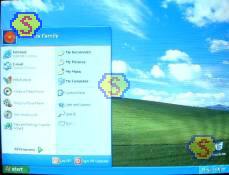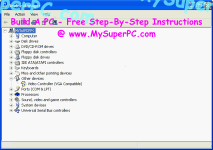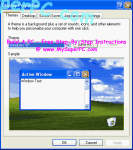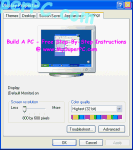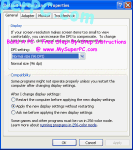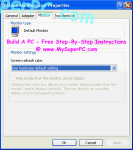Computer Assembly - How To Assemble A PC
Install The Operating System - Windows XP
The operating system of choice is Windows XP due to its compatibility with the latest in hardware. The Windows XP Home Edition Upgrade requires you have a previous copy of Windows 98 or better that can be used for verification.
You may think that Windows XP is no longer "new" since it's been out so long, but in retail time it's still quite new. It's very likely that the drivers provided for nearly everything else, such as the video card, sound card, and so on do not even include a Windows XP compatible driver. If it is included, it may very well not install or not work. And if it does install and appear to work, it's certainly out of date.
This is by no means anything to get disconcerted about. One of the superior qualities of building your own computer is that you'll know when it's finished that it has the latest drivers for everything. So even if the components included a working, compatible driver, you'd still be going to the manufacturer's web-site to get the latest version. But when I say I'd have no problem waiting two years before adopting a new operating system, this is one of the reasons why.
At this point you should be in the BIOS. The First Boot Device is set to CDROM. Insert the Windows XP Home Edition Upgrade CDROM into the CDROM drive. Save and Exit the BIOS. The computer will reset. Let it proceed and it will access and boot from the CDROM drive. You may get a prompt that says "Press any key to boot from CD". Here is the first screen you get for the Windows XP Home Edition Upgrade install. When you get to this screen, press the "Enter" key.
When you're ready, press the "F8" key to accept the Windows Licensing Agreement.
Windows XP now verifies you have a previous copy of Windows 98 or better. Remove the Windows XP CD and insert the CD for your previous copy of Windows into the CD-ROM drive. Then press "Enter".
Windows XP will partition and format the hard drive as part of the install. This is very handy and is much easier than dealing with FDISK. Follow the on screen prompts to create the partitions you desire. Whether or not you even want partitions is entirely up to you. Some prefer just one big partition and that will work. Here are the partitions I made for my own hard drive and how I plan to use them.
-
The first partition, C:, is the biggest at 40GB. I like to put all the executables on C: so I made this a large partition. Programs generally expect to be loaded onto C:. Usually they do just fine on another drive, but occasionally I've run into a difficulty. Putting them on C: ensures there will be no problem. I made C: large because I have a number of games and edutainment packages on the PC, and they can take vast amounts of drive space.
-
The second partition, E:, is 20GB (the CD-ROM uses the logical D: drive) and is used for MP3 music files and videos.
-
The next partition, F:, is 5GB and is used to keep a permanent backup copy of any programs or patches I download to install.
-
The next partition, G:, is 5GB and is used to hold the GoBack disk restoral log file.
-
The next partition, H:, is 5GB and is spare.
-
The next partition, I:, is 2GB and is used to hold my own development programs. That way if they run amok then they'll only gobble up 2GB if hard drive space before crashing rather than the entire hard drive.
-
The next partition, J:, is 1.5GB and is used to hold the Temporary Internet Files for Internet Explorer.
After creating the partitions the way you like, highlight the first entry and press the "Enter" key.
Windows XP will now format the C: partition. It's best to do the thorough format on the drive, not the "Quick" option.
You'll be prompted to return the Windows XP Home Edition Upgrade CD to the CDROM drive before the formatting begins.
Formatting my IBM 120GXP 80GB hard drive took about 20 minutes.
After formatting completes, Windows XP begins to install on the C: drive.
I didn't make any changes at the "Regional and Language Options" page, I just clicked on "Next".
Enter the "Name" and "Organization" for the computer. Then click "Next".
Enter the "Product Key" for your copy of Windows XP which can be found as directed on the screen. Then click "Next".
Enter a name for your computer. Then click "Next".
Select your Time Zone. Then click "Next".
Windows XP is off again to do some more installing, and then...
...you're there!!
Wow! How cool is this? To have a pristine computer at your fingertips. Here we sit with Windows XP installed on the hard drive and nothing else. Kind of creepy to be looking at so much empty. And a bit scary, too. Up until now we've been dealing with mostly hardware. Windows XP was the first software to be installed. The only hardware left to be installed is the modem and sound card, but we've only just started installing the software.
You might notice that the computer seems to be rather sluggish. Moving the mouse, navigating the Windows XP menus, moving windows around, and so forth - just sluggish. And the windows and text displayed on the screen are not clean and crisp and not the right resolution. One important thing to do after installing Windows XP or installing any new hardware is to look at the Device Manager to see if there are any problems. Sure enough, I show a big yellow question mark and a big exclaimation point in the device list, and no mention of the monitor. To see the Device Manager settings, click on Start -> My Computer -> View system information, which brings up the System Properties window, then click the Device Manager button on the Hardware tab. Here's what I see:
Checking the monitor under Display Properties shows it's being recognized as a generic monitor (default monitor) rather than as a Samsung 955DF monitor. To check this right-click on the desktop and select "Properties" from the pop-up menu. The "Display Properties" window appears as shown in the first picture. On the "Settings" tab, click on the "Advanced" button as shown in the second picture. The "Default Monitor" window appears as shown in the third picture. Click on the "Monitor" tab to see that Monitor Type is set to Default Monitor as shown in the fourth picture.
The answer to all of these problems is to load some drivers, namely the motherboard chipset drivers, monitor driver and video card drivers. Normally this would no big deal and nothing unusual, just a simple matter of using the CD-ROMs that came with the motherboard, monitor and video card, respectively. But what I'm about to find out is that the monitor driver and video card drivers that came on their respective CD-ROMs will not load, probably because they were developed without Windows XP in mind. And to make matters worse, I haven't installed the modem card yet so I don't have any access to download them directly to the computer.
Now I've purposefully taken a stepwise approach to building the computer and that's why the components least important to the first bring-up, namely the modem and sound card, have not yet been installed. I could go ahead and install the modem card, and that may be just fine. But things are already out of whack and I'd rather not throw any more variables into the mix. I'd rather stick with my stepwise strategy if I can. And as it turns out, a little download help from another computer and a little patience with floppy disk usage will allow me to do just that. Let's carry on.
Remove the Windows XP Home Edition Upgrade CD from the CD-ROM. Now before you forget, change the BIOS settings for First Boot Device, Second Boot Device and Third Boot Device back to what you want (I use HDD-0 for all three). Restart windows so you'll have a chance to go into the BIOS by clicking Start -> Turn Off Computer -> Restart.
Be aware that all the other hard drives except C: are still "Raw" because they have not yet been formatted. To format a drive, click Start and then My Computer to see all of your logical local hard drives. To format a local hard drive, right-click on it and then select Format from the pop-up window.
I recommend to turn off the Windows screen saver function. Typically the Windows screen saver kicks in after a user defined time period of "inactivity". It's my experience that the screen saver causes problems with other applications. It can be difficult to actually trace the problem to the screen saver since you tend to forget it's even running. In addition, there's no way to predict what it's going to consider "inactivity" and therefore when or even whether it will activate in the middle of whatever else is going on. It has no practical purpose any longer since monitor screen burn in is not a problem with today's monitors. To turn off the screen saver function, right-click on the Desktop, click on Properties in the pop-up menu, select the Screen Saver tab, and for the Screen Saver select "(None)".
My complete recommendations for building a computer with quality components at unbeatable
prices is on my home page at
Build A Computer
Like My Super PC - Cost To Build A Computer. Here again are the recommendations for Windows!
| Description
| Where I Would Get It Today
| Today's Price
| Comments
|
| Windows 10 Home 64-Bit |
Amazon
|
$96.93 |
Free shipping! OEM version, which is fine for building your own computer. Clicking the link takes you directly to it.
|
|
Back to My Super PC - Home Page
Skip Ahead
Back to My Super PC - Home Page
© 2001-2011, Rob Williams, all rights reserved.
|

|

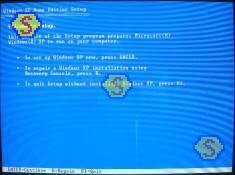 Windows XP now verifies you have a previous copy of Windows 98 or better. Remove the Windows XP CD and insert the CD for your previous copy of Windows into the CD-ROM drive. Then press "Enter".
Windows XP now verifies you have a previous copy of Windows 98 or better. Remove the Windows XP CD and insert the CD for your previous copy of Windows into the CD-ROM drive. Then press "Enter".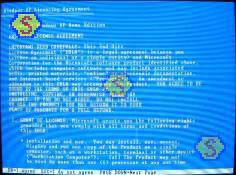 Windows XP will partition and format the hard drive as part of the install. This is very handy and is much easier than dealing with FDISK. Follow the on screen prompts to create the partitions you desire. Whether or not you even want partitions is entirely up to you. Some prefer just one big partition and that will work. Here are the partitions I made for my own hard drive and how I plan to use them.
Windows XP will partition and format the hard drive as part of the install. This is very handy and is much easier than dealing with FDISK. Follow the on screen prompts to create the partitions you desire. Whether or not you even want partitions is entirely up to you. Some prefer just one big partition and that will work. Here are the partitions I made for my own hard drive and how I plan to use them.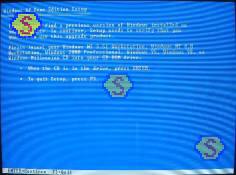
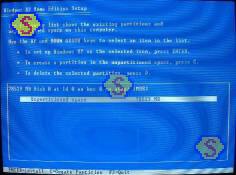 Windows XP will now format the C: partition. It's best to do the thorough format on the drive, not the "Quick" option.
Windows XP will now format the C: partition. It's best to do the thorough format on the drive, not the "Quick" option.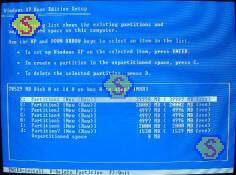 You'll be prompted to return the Windows XP Home Edition Upgrade CD to the CDROM drive before the formatting begins.
You'll be prompted to return the Windows XP Home Edition Upgrade CD to the CDROM drive before the formatting begins.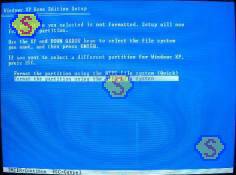 Formatting my IBM 120GXP 80GB hard drive took about 20 minutes.
Formatting my IBM 120GXP 80GB hard drive took about 20 minutes.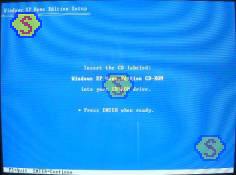 After formatting completes, Windows XP begins to install on the C: drive.
After formatting completes, Windows XP begins to install on the C: drive.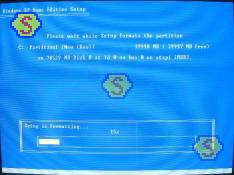 I didn't make any changes at the "Regional and Language Options" page, I just clicked on "Next".
I didn't make any changes at the "Regional and Language Options" page, I just clicked on "Next".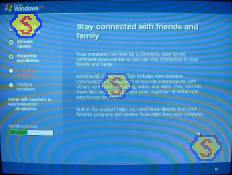 Enter the "Name" and "Organization" for the computer. Then click "Next".
Enter the "Name" and "Organization" for the computer. Then click "Next".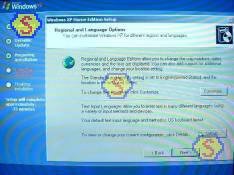 Enter the "Product Key" for your copy of Windows XP which can be found as directed on the screen. Then click "Next".
Enter the "Product Key" for your copy of Windows XP which can be found as directed on the screen. Then click "Next".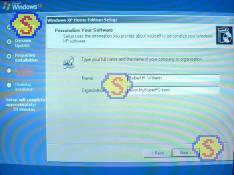 Enter a name for your computer. Then click "Next".
Enter a name for your computer. Then click "Next".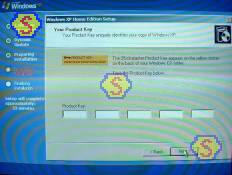 Select your Time Zone. Then click "Next".
Select your Time Zone. Then click "Next".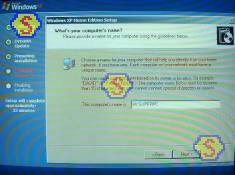 Windows XP is off again to do some more installing, and then...
Windows XP is off again to do some more installing, and then...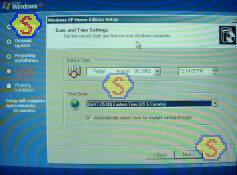 ...you're there!!
...you're there!!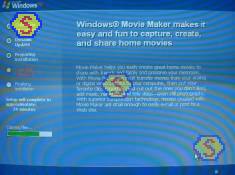 Wow! How cool is this? To have a pristine computer at your fingertips. Here we sit with Windows XP installed on the hard drive and nothing else. Kind of creepy to be looking at so much empty. And a bit scary, too. Up until now we've been dealing with mostly hardware. Windows XP was the first software to be installed. The only hardware left to be installed is the modem and sound card, but we've only just started installing the software.
Wow! How cool is this? To have a pristine computer at your fingertips. Here we sit with Windows XP installed on the hard drive and nothing else. Kind of creepy to be looking at so much empty. And a bit scary, too. Up until now we've been dealing with mostly hardware. Windows XP was the first software to be installed. The only hardware left to be installed is the modem and sound card, but we've only just started installing the software.